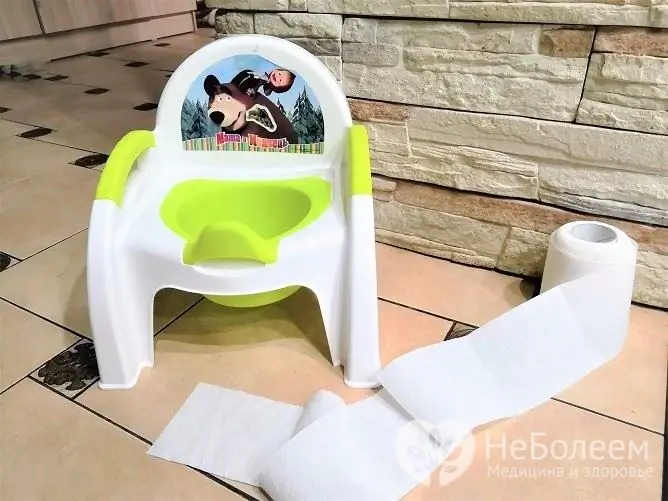- Author Rachel Wainwright [email protected].
- Public 2024-01-15 19:51.
- Last modified 2025-11-02 20:14.
Constipation in a child 4-5 years old
The content of the article:
- Features of constipation in children
-
The main causes of constipation
- Development mechanism
- Why arises
- Symptoms
- Diagnostic methods
-
Constipation in a 5-year-old child: what to do at home
- General recommendations
- Diet
- Folk remedies
- Laxatives
- Enema
- Video
Constipation in a 4-year-old child is a common problem. Difficulty defecating can be associated with a variety of reasons, ranging from psychological to serious bowel disease. Parents can deal with recurrent symptoms at home. For this, you need to revise the diet, give the baby more water to drink, use medicinal herbs with a laxative effect. In chronic constipation, you need to see a doctor for an additional examination.

In most cases, constipation in children 4-5 years old is associated with errors in nutrition and lifestyle
Features of constipation in children
Normally, children aged 4-5 years empty their intestines once a day. Some deviations associated with dietary habits, moving, inability to visit the toilet and other factors are acceptable. So, if a child has a bowel movement less than 1 time in 2 days (3 times a week), it is constipation.
In addition to the frequency of bowel movements, constipation is characterized by a change in the shape of the stool. Normally, in children after 4 years of age, the feces are formalized, not dense, and have no inclusions in the form of breasts.
The main causes of constipation
There is no single cause that would lead to constipation in a child. Impaired bowel movement can be associated with a number of factors: unhealthy diet, stress, a sedentary lifestyle, bowel and nervous tissue diseases.
Development mechanism
The mechanism for the development of constipation in a baby can be associated with several factors:
- weakened peristalsis, food moves more slowly along the digestive tract;
- there is less liquid in the feces, which makes it difficult to pass through the intestines;
- antiperistalsis is expressed - there is a movement of feces in the opposite direction;
- violation of the direct act of defecation (from the rectum, anal sphincter).
Why arises
There are several groups of reasons that can lead to difficulty in defecation - alimentary, psychological, organic (diseases of the colon, nervous system and other organs).
| Group of reasons | Explanation |
| Alimentary |
The most common group of reasons. More than half of cases of constipation in children are associated with inaccuracies in nutrition, insufficient fluid intake. What dietary habits can affect the difficulty of defecation: · The child drinks little water during the day; • there is not enough fiber in the diet; · Mashed dishes prevail: soups, mashed potatoes, semolina porridge, jelly; · Excessive consumption of proteins and fats. The development of constipation can provoke an improper diet - if the child eats rarely, but in large portions. The atmosphere during the meal also influences, for example, if the child eats on the go, is in a hurry, does not chew food thoroughly. |
| Psychological |
Often, constipation occurs in children during the adaptation period - attending kindergarten, changing residence. Constant suppression of the reflex leads to compaction of feces, trauma to the intestinal mucosa. Also, the reason may be a fear of the pot, when the child avoids going to the toilet because of previous pain. |
| Colon diseases |
Chronic constipation is often a symptom of bowel disease. Depending on the localization, there are 2 types of it: Cologenic - associated with a slowdown in passage through the colon, the cause may be Hirschsprung's disease, dolichosigma, megacolon, colitis, helminthic invasion; · Proctogenic - associated with a violation of the direct act of defecation, the cause is damage to the rectum and anal sphincter. |
| Nerve tissue pathology | If the nerves, brain or spinal cord are damaged, the innervation of the intestines can be disrupted. This leads to an increase or decrease in peristalsis. |
| Diseases of other organs | Disorders of defecation can lead to diseases not only of the digestive tract and nervous system, but also of other organs. For example, hypothyroidism is often accompanied by a slowdown in the evacuation of feces. |
Symptoms
The main manifestation of constipation is that the child empties the intestines less often than 1 time in 2 days. Changes in the frequency of bowel movements may be accompanied by other signs:
- dense, dry, "sheep" feces;
- defecation is accompanied by painful sensations;
- the child cannot go to the toilet without additional help (finger manipulation, laxative, enema).
As a result of the slow movement of feces through the intestines, the absorption of decay products increases, which can lead to general intoxication. In this case, the child becomes lethargic, gets tired quickly, his appetite decreases, his sleep is disturbed, and his temperature rises.
Diagnostic methods
If stool retention is observed for a long time, you need to contact your pediatrician. The doctor will examine the baby, palpate the abdomen and finger examination, and check the anal reflex. If necessary, an additional examination is prescribed:
- coprogram;
- analysis of feces for eggs of worms;
- general blood analysis;
- irrigoscopy (X-ray examination of the intestine with contrast);
- colonoscopy (endoscopic examination).
Constipation in a 5-year-old child: what to do at home
In most cases, treatment can be done at home. A prerequisite for getting rid of constipation is the correction of the child's lifestyle. Other treatments are also used - massage, herbs, exercise, enemas, and laxatives.
General recommendations
One of the most important components of home treatment is lifestyle correction. Tips to help relieve constipation:
- Give your child a glass of water immediately upon waking up. This will activate the peristalsis of the large intestine, and it will be easier for the baby to go to the toilet.
- Form a bowel movement. Teach your child to go to the toilet at the same time, preferably in the morning. Do not allow negative emotions and discomfort during the act of defecation.
- If there are psychological reasons - talk to the child, ask what worries him.
- Abdominal massage helps to enhance peristalsis. Before eating, gently massage your baby's belly clockwise for 5 minutes.
- Let your child move more. Limit the time of his sitting at the TV and computer, walk more with him on the street, play active games.

It is important to form the child's habit of emptying the intestines at about the same time, providing him with a comfortable environment.
Diet
It is necessary to effectively treat pathology at home, first of all, by correcting nutrition.
What is recommended to give your baby to improve colon function:
- Foods high in fiber: fresh fruits and vegetables, berries, greens, rye bread, oat and buckwheat porridge, bran.
- Products that improve intestinal motility and prevent dysbiosis: kefir, yogurt, fermented baked milk, natural yogurt.
- Dried fruits: prunes, raisins, dried apricots.
Do not forget about the water regime - sufficient fluid intake softens the feces and facilitates their excretion. The baby needs to drink about 50 ml of water per 1 kg of weight per day.
Folk remedies
There is also an old "grandmother's" way of dealing with constipation - the use of decoctions and infusions of medicinal herbs.
| Folk remedy | How to cook | How to use |
| Flax seed infusion | For cooking, you need 3 tablespoons of flax seeds, 200 ml of boiling water. Pour flax seeds with boiling water, leave overnight. | Take 1 tablespoon 3 times a day. |
| Rhubarb and buckthorn broth | For preparation, you will need 1 teaspoon of rhubarb root, 1 teaspoon of buckthorn bark, 200 ml of water. Pour the mixture with water, hold in a water bath for 15 minutes. | Take 2 tablespoons before bed. |
| Senna leaf infusion | Pour 200 ml of boiling water over 1 tablespoon of senna leaves. Insist for 8 hours. | Take 1 tablespoon 3 times a day 30 minutes after meals. |
| Prune decoction | For cooking, you need 100 g of prunes, 400 ml of water. Rinse the prunes under water, pour in boiling water, cook for 15-20 minutes. | Take 50 ml 3 times daily before meals. |
Laxatives
If non-drug treatment is ineffective, laxatives can be used (strictly with the permission of the pediatrician). Or the action is associated with the stimulation of peristalsis or the softening of feces. The use of laxatives should not be overused, as it can be addictive.
What laxative can be given to a baby at the age of 4-5 years:
| Drug group name | How it works, examples |
| Lactulose based preparations | Lactulose has a mild laxative effect, and also promotes the colonization of normal microflora. Babies can be given Duphalac, Normase, Portalac, as well as Dinolac, a drug that, in addition to lactulose, contains simethicone (prevents increased gas formation). |
| Herbal preparations | The composition of herbal remedies includes senna leaves - this is a plant that accelerates peristalsis. Can be given to Senade, Senadexin. |
| Preparations based on sodium picosulfate | You can use Guttalax, Slabikap, Laxigal in the form of drops. These are emergency medications and cannot be used for several days in a row. |
| Glycerin candles | They act gently, soften stool and do not irritate the colon mucosa. They are administered rectally and are not recommended for long-term use, as they can be addictive. |
| Vegetable oils | The baby can be given castor oil or vaseline oil internally. These are safe remedies, they gently affect the intestines, facilitate the introduction of feces. |

Laxatives in children are used strictly according to the doctor's prescription and for a limited time
Enema
Enema is a quick and effective method of bowel cleansing. To set an enema, you will need a pear, petroleum jelly and rinsing fluid (300 ml of warm or cool water, chamomile decoction).
How to give an enema:
- Lay the baby on the left side with the legs bent at the knees.
- Lubricate the tip of the pear with Vaseline.
- Insert the tip into the anus to a depth of 3 cm.
- Squeeze the pear and inject its contents into the rectum.
- Pull out the tip slowly.
Despite the effectiveness of the method, the use of enemas is often not recommended. The child may become accustomed to emptying only after an enema. In addition, the procedure irritates the intestinal mucosa.
Video
We offer for viewing a video on the topic of the article.

Anna Kozlova Medical journalist About the author
Education: Rostov State Medical University, specialty "General Medicine".
Found a mistake in the text? Select it and press Ctrl + Enter.






